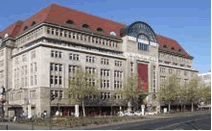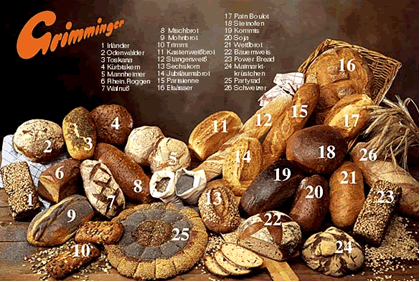| Section Three: Part B
Kurfürstendamm or Ku'damm
 On the west side of the city center of Berlin is a famous boulevard known as Kurfürstendamm, or by locals simply as the Ku'damm. Originally laid out in the 16th century as a 3.5 km path between the residential palace and the hunting palace just outside the city, the boulevard was named in the 19 th century after the former Kurfürste (Electors) of the Holy Roman Empire. During the time that East and West Berlin were separated the Kurfürstendamm was the main business street of West Berlin. Today it remains an upscale shopping area, featuring the largest department store in Europe, the KaDeWe (“kah day vay”), short for Kaufhaus des Westens (“department store of the west”), along with many other specialty shops, theaters, department stores, and plenty of Kaffeehäuser, or coffee shops and cafès. On the west side of the city center of Berlin is a famous boulevard known as Kurfürstendamm, or by locals simply as the Ku'damm. Originally laid out in the 16th century as a 3.5 km path between the residential palace and the hunting palace just outside the city, the boulevard was named in the 19 th century after the former Kurfürste (Electors) of the Holy Roman Empire. During the time that East and West Berlin were separated the Kurfürstendamm was the main business street of West Berlin. Today it remains an upscale shopping area, featuring the largest department store in Europe, the KaDeWe (“kah day vay”), short for Kaufhaus des Westens (“department store of the west”), along with many other specialty shops, theaters, department stores, and plenty of Kaffeehäuser, or coffee shops and cafès.
 As you stroll along the boulevard, you will also see the famous Kaiser Wilhelm Gedächtniskirche, which is a memorial church to the Kaiser Wilhelm. The original church was destroyed during WWII in a bombing raid of Berlin. The only part of the original church that is still standing today is the church steeple, but even part of that is missing, as you can see from the photograph. The new addition is a sight to see, and it's free! So if you are in Berlin, be sure to pop inside to see the magical effects of huge deep blue stained glass windows that pour blue light into the historic church. As you stroll along the boulevard, you will also see the famous Kaiser Wilhelm Gedächtniskirche, which is a memorial church to the Kaiser Wilhelm. The original church was destroyed during WWII in a bombing raid of Berlin. The only part of the original church that is still standing today is the church steeple, but even part of that is missing, as you can see from the photograph. The new addition is a sight to see, and it's free! So if you are in Berlin, be sure to pop inside to see the magical effects of huge deep blue stained glass windows that pour blue light into the historic church.
If you visit the Ku'damm, be sure that you stop by the famous Cafê Kranzler for an Eis, or ice cream sundae. You will find that German ice cream is somewhat different from the American kind – and portions are a bit smaller. Eis is a very popular treat on a hot summer day of sightseeing in Berlin!
Berliner Pfannkuchen and the German Bäckerei
The Berliner Pfannkuchen, or Berliner (jelly filled doughnut), is a popular and tasty bakery treat. In the United States, it's easy to find doughnut shops, or at least to find doughnuts in large grocery stores. Not so in Germany! Doughnuts are a special treat, and in order to find them, you will need to find a Bäckerei (Bakery) or find them sold at a fair or a fest. You won't find the same doughnut selection there either, but you will find some other tasty treats at the Bäckerei.
 The German bakeries are quite different than what you might find in the United States. They are usually their own shops, but some larger supermarket chains also usually have a bakery within the store. Bakeries are plentiful, as breads and rolls are a mainstay of the German diet. You will find a bakery in even the smallest of villages, and for many Germans an early-morning trip to the bakery for fresh rolls is part of the daily routine. At any bakery you will find a wide variety of breads and rolls, and usually pastries, and other sweets available, though you will be more likely to find cakes, tortes and sweets at a Konditorei (cake shop). The German bakeries are quite different than what you might find in the United States. They are usually their own shops, but some larger supermarket chains also usually have a bakery within the store. Bakeries are plentiful, as breads and rolls are a mainstay of the German diet. You will find a bakery in even the smallest of villages, and for many Germans an early-morning trip to the bakery for fresh rolls is part of the daily routine. At any bakery you will find a wide variety of breads and rolls, and usually pastries, and other sweets available, though you will be more likely to find cakes, tortes and sweets at a Konditorei (cake shop).
 Discussion Assignment Discussion Assignment
Go to the discussion area and submit a posting asking at least
four questions using your new skills in German. While you are there, take
time to respond to two posts by some other student. If there are no other
posts at this point, visit the area later to respond to two questions.
This assignment is worth 16 points.
Go on to Part C. |